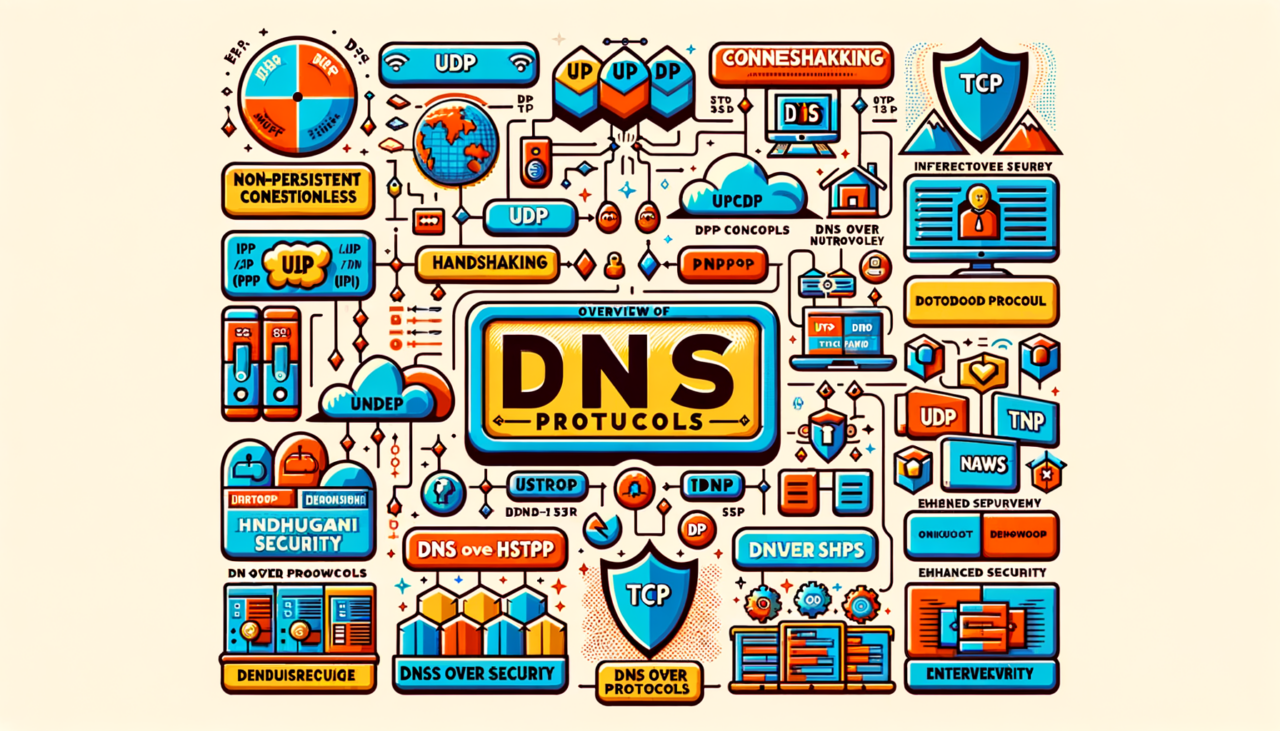In the vast digital landscape, where every click and connection is a dance of data, the Domain Name System (DNS) serves as the grand conductor orchestrating the symphony of the internet. For those unfamiliar, DNS translates human-friendly domain names like www.example.com into IP addresses that computers use to identify each other on the network. This essential function allows us to navigate the web with ease, much like a traveler in Tehran’s bustling bazaars guided by a knowledgeable local. In this article, we will journey through the various DNS protocols, exploring their nuances and the roles they play in this intricate system.
The Pillars of DNS Protocols
DNS operates primarily over two transport protocols: User Datagram Protocol (UDP) and Transmission Control Protocol (TCP). Additionally, as security and privacy have become paramount in our digital lives, newer protocols like DNS over HTTPS (DoH) and DNS over TLS (DoT) have emerged. Each protocol has its own strengths and weaknesses, much like the diverse culinary delights of Persian cuisine—each dish unique, yet all contributing to the rich tapestry of flavors.
1. User Datagram Protocol (UDP)
UDP is the most commonly used protocol in DNS queries. It is connectionless, meaning that it does not require a connection to be established before data is sent. This characteristic allows for faster query times, making it ideal for the quick lookups that DNS typically handles.
Key Features of UDP:
| Feature | Description |
|---|---|
| Connectionless | No need to establish a connection before sending data. |
| Low Latency | Fast response times due to minimal overhead. |
| No Retransmission | If a packet is lost, it is not retransmitted. |
Example of a DNS Query Using UDP
Client (UDP) -> DNS Server:
Query: "What is the IP address of www.example.com?"
DNS Server (UDP) -> Client:
Response: "The IP address of www.example.com is 93.184.216.34"
2. Transmission Control Protocol (TCP)
While UDP is favored for its speed, TCP is employed in scenarios where reliability is critical. This is particularly true for tasks such as zone transfers between DNS servers or when the response data size exceeds 512 bytes (the traditional limit for UDP).
Key Features of TCP:
| Feature | Description |
|---|---|
| Connection-oriented | Requires a connection to be established before data is sent. |
| Reliable Delivery | Guarantees that packets are delivered in order and without loss. |
| Flow Control | Manages the rate of data transmission to prevent overwhelming the receiver. |
Example of a DNS Query Using TCP
Client (TCP) -> DNS Server:
[Establish TCP connection]
Query: "What is the IP address of www.example.com?"
DNS Server (TCP) -> Client:
Response: "The IP address of www.example.com is 93.184.216.34"
[Terminate TCP connection]
3. DNS over HTTPS (DoH)
As concerns regarding privacy and data security have risen, DNS over HTTPS (DoH) has emerged as a modern solution. This protocol encrypts DNS queries and responses, encapsulating them in HTTPS requests. It prevents eavesdropping and tampering, akin to how a warm Persian scarf protects one from the biting winter wind.
Key Features of DoH:
| Feature | Description |
|---|---|
| Encryption | Encrypts DNS queries to enhance privacy. |
| HTTP/2 Support | Utilizes the advantages of HTTP/2 for improved performance. |
| Bypassing Filters | Can bypass certain network-level filters and censorship. |
Example of a DNS Query Using DoH
Client (DoH) -> DNS Server:
POST https://dns.example.com/dns-query
Content-Type: application/dns-json
{
"name": "www.example.com",
"type": "A"
}
DNS Server (DoH) -> Client:
HTTP/2 200 OK
Content-Type: application/dns-json
{
"Answer": [
{
"name": "www.example.com",
"type": "A",
"data": "93.184.216.34"
}
]
}
4. DNS over TLS (DoT)
Similar to DoH, DNS over TLS (DoT) encrypts DNS queries to safeguard user privacy. However, it runs over a dedicated port (853) and uses the TLS protocol for encryption, offering an alternative for users seeking secure DNS resolution.
Key Features of DoT:
| Feature | Description |
|---|---|
| Encryption | Provides confidentiality through TLS. |
| Dedicated Port | Uses port 853, which can make it easier to block if needed. |
| Greater Compatibility | Works with traditional DNS setups while providing encryption. |
Example of a DNS Query Using DoT
Client (DoT) -> DNS Server:
[Establish TLS connection]
Query: "What is the IP address of www.example.com?"
DNS Server (DoT) -> Client:
Response: "The IP address of www.example.com is 93.184.216.34"
[Terminate TLS connection]
Conclusion: The Harmonious Blend of Protocols
As we reflect on the various DNS protocols, it’s clear that each serves a unique purpose, much like the layers of flavor in a rich Persian stew. UDP offers speed, TCP ensures reliability, while DoH and DoT elevate privacy and security to new heights. Understanding these protocols not only empowers us as users but also enriches our appreciation for the underlying technology that connects us globally.
In a world increasingly defined by digital interactions, being informed about how our data travels can provide peace of mind—a cultural value that resonates deeply within my heritage. Just as the stories of my ancestors have been passed down through generations, so too will the knowledge of DNS protocols empower future generations to navigate the complexities of the internet with confidence.
As you continue your journey through the digital realm, remember that behind every website you visit lies a foundation built on these protocols, each contributing to the seamless experience we often take for granted. Embrace this knowledge, and you’ll find yourself not just a user of technology, but a steward of the digital world.

Comments (0)
There are no comments here yet, you can be the first!